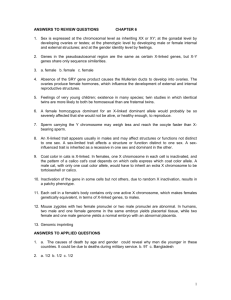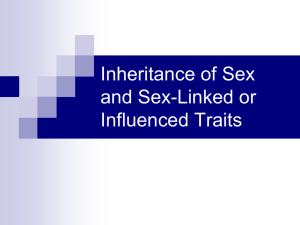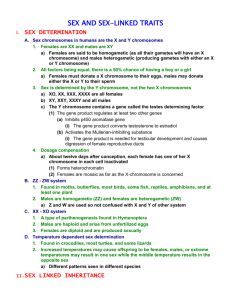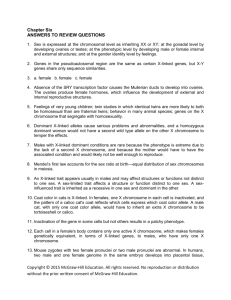Sex Determination and Linkage (Chp. 6) I.
advertisement
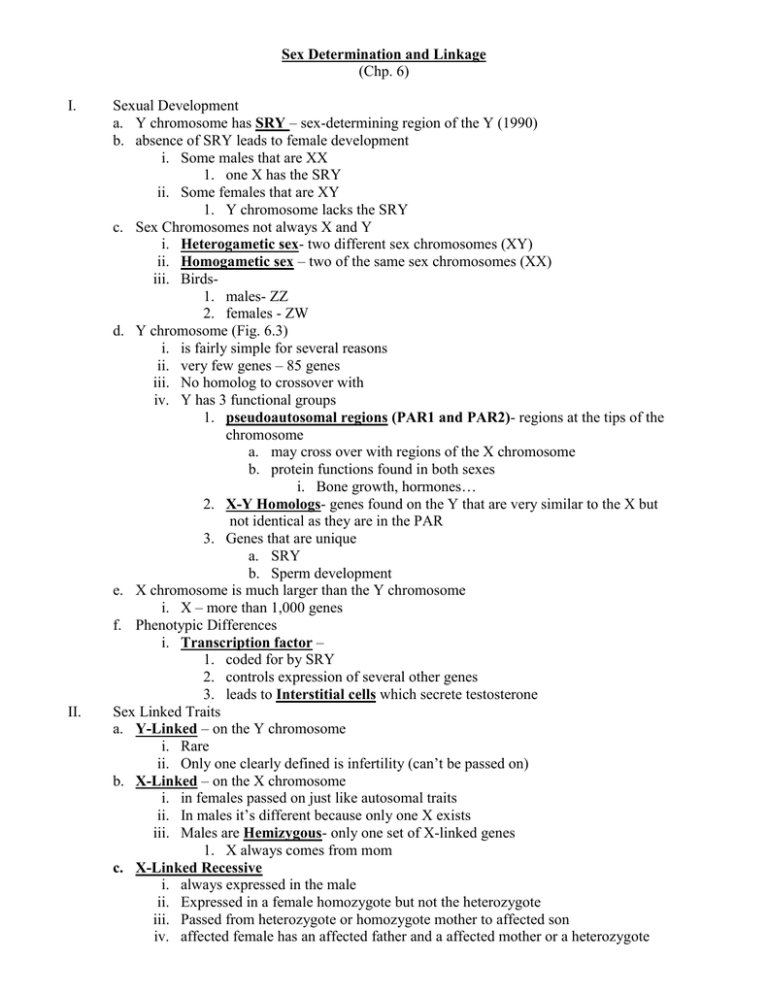
Sex Determination and Linkage (Chp. 6) I. II. Sexual Development a. Y chromosome has SRY – sex-determining region of the Y (1990) b. absence of SRY leads to female development i. Some males that are XX 1. one X has the SRY ii. Some females that are XY 1. Y chromosome lacks the SRY c. Sex Chromosomes not always X and Y i. Heterogametic sex- two different sex chromosomes (XY) ii. Homogametic sex – two of the same sex chromosomes (XX) iii. Birds1. males- ZZ 2. females - ZW d. Y chromosome (Fig. 6.3) i. is fairly simple for several reasons ii. very few genes – 85 genes iii. No homolog to crossover with iv. Y has 3 functional groups 1. pseudoautosomal regions (PAR1 and PAR2)- regions at the tips of the chromosome a. may cross over with regions of the X chromosome b. protein functions found in both sexes i. Bone growth, hormones… 2. X-Y Homologs- genes found on the Y that are very similar to the X but not identical as they are in the PAR 3. Genes that are unique a. SRY b. Sperm development e. X chromosome is much larger than the Y chromosome i. X – more than 1,000 genes f. Phenotypic Differences i. Transcription factor – 1. coded for by SRY 2. controls expression of several other genes 3. leads to Interstitial cells which secrete testosterone Sex Linked Traits a. Y-Linked – on the Y chromosome i. Rare ii. Only one clearly defined is infertility (can’t be passed on) b. X-Linked – on the X chromosome i. in females passed on just like autosomal traits ii. In males it’s different because only one X exists iii. Males are Hemizygous- only one set of X-linked genes 1. X always comes from mom c. X-Linked Recessive i. always expressed in the male ii. Expressed in a female homozygote but not the heterozygote iii. Passed from heterozygote or homozygote mother to affected son iv. affected female has an affected father and a affected mother or a heterozygote III. IV. mother v. EX: ichthyosis, color blindness, hemophilia d. X-Linked Dominant i. expressed in female in one copy ii. expressed more severely in male iii. high rate of miscarriage due to early lethality in males iv. EX: incontinetia pigmenti, hypertrichosis (extra hair follicles) X- Inactivation- Fig. 6.13 a. most of the genes on one X chromosome in each cell are inactivated b. which X (from mother or father) is inactivated is random c. females express traits from mother in some cells and traits from father in other cells d. Barr Bodyi. the inactivated X chromosome ii. only present in females e. Manifesting Heterozygotei. A carrier of an X-linked trait who expresses the phenotype ii. due to X-inactivation Gender Effects on Phenotype a. Sex-limited Traitsi. a structure or function of the body that is present in only males or only females ii. ex: horn development, milk yield, beard growth… iii. genes are transmitted by parents but hormones are not present to express trait b. Sex-influenced Traitsi. an allele is dominant in one sex and recessive in another 1. caused by hormonal differences 2. ex: male pattern baldness (Bb male = bald, bb female = bald) c. Genomic Imprinting- (parent of origin) – Fig. 6.15 i. difference in gene expression of a gene or chromosomal region depending upon whether it is inherited from the father or the mother and depending on male or female ii. women can have sons and men can have daughters without passing on their sex-specific parental imprints

